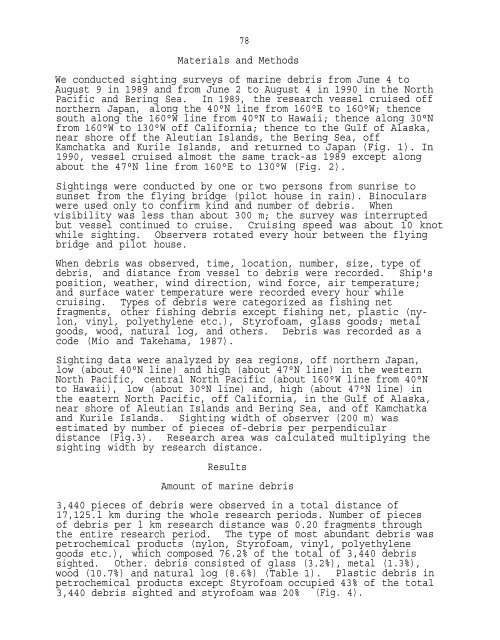Poster abstracts and manuscripts from the Third International ...
Poster abstracts and manuscripts from the Third International ...
Poster abstracts and manuscripts from the Third International ...
Create successful ePaper yourself
Turn your PDF publications into a flip-book with our unique Google optimized e-Paper software.
78<br />
Materials <strong>and</strong> Methods<br />
We conducted sighting surveys of marine debris <strong>from</strong> June 4 to<br />
August 9 in 1989 <strong>and</strong> <strong>from</strong> June 2 to August 4 in 1990 in <strong>the</strong> North<br />
Pacific <strong>and</strong> Bering Sea. In 1989, <strong>the</strong> research vessel cruised off<br />
nor<strong>the</strong>rn Japan, along <strong>the</strong> 40°N line <strong>from</strong> 160°E to 16O°W; <strong>the</strong>nce<br />
south along <strong>the</strong> 160°W line <strong>from</strong> 40°N to Hawaii; <strong>the</strong>nce along 30°N<br />
<strong>from</strong> 160°W to 130°W off California; <strong>the</strong>nce to <strong>the</strong> Gulf of Alaska,<br />
near shore off <strong>the</strong> Aleutian Isl<strong>and</strong>s, <strong>the</strong> Bering Sea, off<br />
Kamchatka <strong>and</strong> Kurile Isl<strong>and</strong>s, <strong>and</strong> returned to Japan (Fig. 1). In<br />
1990, vessel cruised almost <strong>the</strong> same track-as 1989 except along<br />
about <strong>the</strong> 47°N line <strong>from</strong> 160°E to 130°W (Fig. 2).<br />
Sightings were conducted by one or two persons <strong>from</strong> sunrise to<br />
sunset <strong>from</strong> <strong>the</strong> flying bridge (pilot house in rain). Binoculars<br />
were used only to confirm kind <strong>and</strong> number of debris. When<br />
visibility was less than about 300 m; <strong>the</strong> survey was interrupted<br />
but vessel continued to cruise. Cruising speed was about 10 knot<br />
while sighting. Observers rotated every hour between <strong>the</strong> flying<br />
bridge <strong>and</strong> pilot house.<br />
When debris was observed, time, location, number, size, type of<br />
debris, <strong>and</strong> distance <strong>from</strong> vessel to debris were recorded. Ship's<br />
position, wea<strong>the</strong>r, wind direction, wind force, air temperature;<br />
<strong>and</strong> surface water temperature were recorded every hour while<br />
cruising. Types of debris were categorized as fishing net<br />
fragments, o<strong>the</strong>r fishing debris except fishing net, plastic (nylon,<br />
vinyl, polyethylene etc.), Styrofoam, glass goods; metal<br />
goods, wood, natural log, <strong>and</strong> o<strong>the</strong>rs. Debris was recorded as a<br />
code (Mio <strong>and</strong> Takehama, 1987).<br />
Sighting data were analyzed by sea regions, off nor<strong>the</strong>rn Japan,<br />
low (about 40°N line) <strong>and</strong> high (about 47°N line) in <strong>the</strong> western<br />
North Pacific, central North Pacific (about 160°W line <strong>from</strong> 40°N<br />
to Hawaii), low (about 30°N line) <strong>and</strong>, high (about 47°N line) in<br />
<strong>the</strong> eastern North Pacific, off California, in <strong>the</strong> Gulf of Alaska,<br />
near shore of Aleutian Isl<strong>and</strong>s <strong>and</strong> Bering Sea, <strong>and</strong> off Kamchatka<br />
<strong>and</strong> Kurile Isl<strong>and</strong>s. Sighting width of observer (200 m) was<br />
estimated by number of pieces of-debris per perpendicular<br />
distance (Fig.3). Research area was calculated multiplying <strong>the</strong><br />
sighting width by research distance.<br />
Results<br />
Amount of marine debris<br />
3,440 pieces of debris were observed in a total distance of<br />
17,125.l km during <strong>the</strong> whole research periods. Number of pieces<br />
of debris per l km research distance was 0.20 fragments through<br />
<strong>the</strong> entire research period. The type of most abundant debris was<br />
petrochemical products (nylon, Styrofoam, vinyl, polyethylene<br />
goods etc.), which composed 76.2% of <strong>the</strong> total of 3,440 debris<br />
sighted. O<strong>the</strong>r. debris consisted of glass (3.2%), metal (1.3%),<br />
wood (10.7%) <strong>and</strong> natural log (8.6%) (Table 1). Plastic debris in<br />
petrochemical products except Styrofoam occupied 43% of <strong>the</strong> total<br />
3,440 debris sighted <strong>and</strong> styrofoam was 20% (Fig. 4).
















